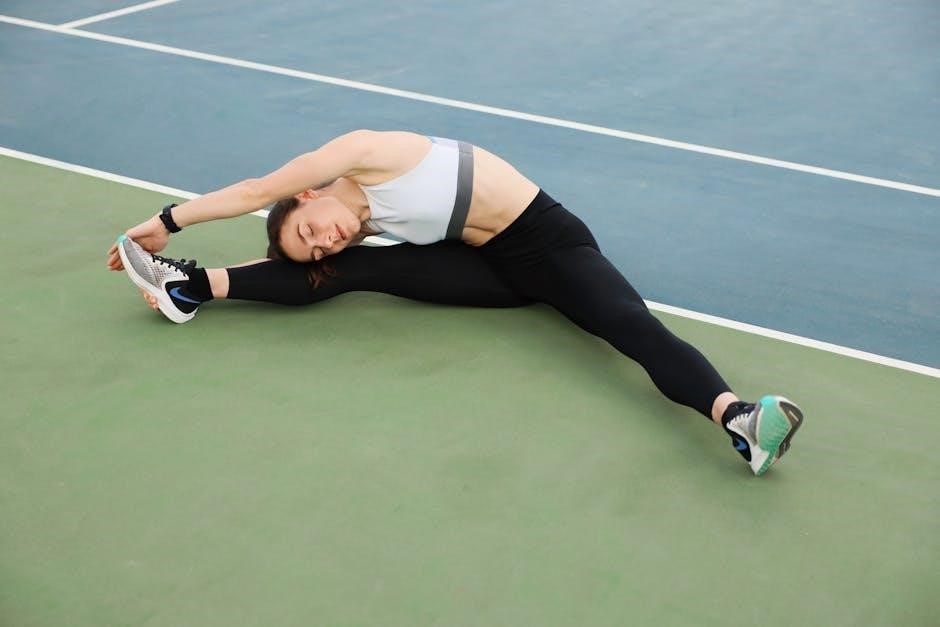Golfer’s elbow, or medial epicondylitis, is a condition causing pain on the inner elbow and forearm due to overuse or repetitive strain. It often affects golfers, tennis players, and individuals with repetitive gripping activities. Symptoms include tenderness near the elbow, pain during wrist flexion, and discomfort when performing daily tasks. While it can interfere with sports and daily life, targeted exercises play a crucial role in recovery and prevention.
1.1 Definition of Golfers Elbow (Medial Epicondylitis)
Golfer’s elbow, or medial epicondylitis, is a condition characterized by inflammation or degeneration of the tendons attaching to the medial epicondyle, the bony bump on the inside of the elbow. It results from repetitive strain or overuse of the forearm flexor muscles, leading to pain and tenderness near the elbow and forearm. This condition is common in golfers, tennis players, and individuals engaged in activities involving repetitive gripping or wrist flexion.
1.2 Common Symptoms and Pain Areas
Golfer’s elbow typically causes pain on the inner side of the elbow and forearm, often radiating down to the wrist. Pain is usually exacerbated by activities involving wrist flexion, gripping, or twisting motions. Tenderness is commonly felt near the medial epicondyle, the bony prominence on the elbow’s inner side. Symptoms may also include stiffness, weakness in the forearm, and difficulty performing tasks like lifting or gripping objects. Pain often worsens with repetitive movements, making everyday activities challenging.
1.3 Importance of Exercises in Treatment
Exercises are crucial in treating golfer’s elbow, focusing on stretching and strengthening the forearm muscles and tendons. Stretching enhances flexibility, reducing stiffness, while strengthening improves muscle endurance and tendon resilience. Eccentric exercises, in particular, target the damaged tendons, promoting repair and preventing recurrence. Regular exercise regimes can alleviate pain, restore function, and expedite recovery, allowing individuals to return to their activities without discomfort or limitations. A structured exercise plan is often the cornerstone of effective management and long-term relief from symptoms.

Understanding the Causes of Golfers Elbow
Golfer’s elbow primarily results from overuse of forearm muscles, repetitive strain, and improper swing mechanics, leading to tendon inflammation and discomfort.
2.1 Overuse of Forearm Muscles
Overuse of the forearm muscles is a primary cause of golfer’s elbow. Repetitive activities, such as gripping, twisting, or flexing, strain the tendons attaching these muscles to the elbow. This strain can lead to inflammation and pain, particularly on the inner elbow. Activities like golf swings, tennis serves, or even repetitive daily tasks can contribute to this condition. Prolonged overuse without adequate rest accelerates tendon wear and tear.
2.2 Repetitive Movements and Activities
Repetitive movements, such as gripping, twisting, or flexing, are common contributors to golfer’s elbow. Activities like golf swings, tennis serves, or even repetitive daily tasks can strain the forearm tendons. Over time, these movements lead to inflammation and pain on the inner elbow. Without proper rest, the tendons become worn, exacerbating the condition. It’s essential to identify and modify these repetitive actions to prevent further injury and promote healing.
2.3 Poor Golf Swing Mechanics
Poor golf swing mechanics can significantly contribute to golfer’s elbow. An improper grip, wrist position, or follow-through increases strain on the medial tendons. For right-handed golfers, a swing that generates power from the left side can overburden the inner elbow, leading to pain and inflammation. Addressing these mechanical flaws through coaching and practice is crucial to prevent the onset or worsening of the condition. Proper technique reduces repetitive stress on the forearm muscles and tendons.
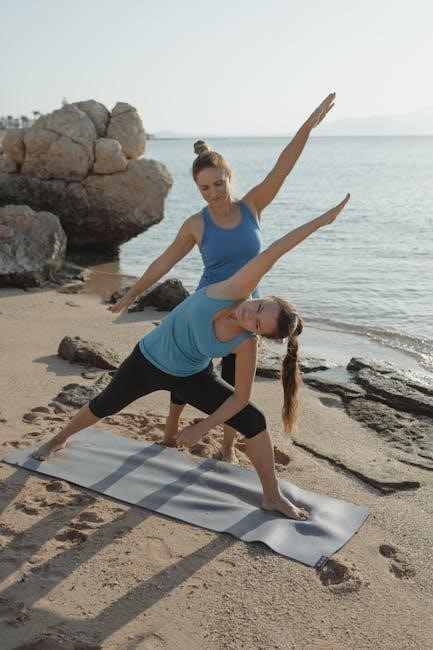
Diagnosis and Symptoms
Golfer’s elbow is typically diagnosed through medical history and physical exams. Key symptoms include pain on the inner elbow, forearm tenderness, and discomfort during gripping or twisting motions.
3.1 Medical History and Physical Exam
A doctor diagnoses golfer’s elbow by reviewing the patient’s medical history and conducting a physical exam. They assess pain locations, tenderness near the medial epicondyle, and discomfort during specific movements like wrist flexion or gripping. The exam may involve applying pressure to the affected area to reproduce symptoms. This approach helps differentiate golfer’s elbow from other elbow conditions, ensuring an accurate diagnosis and appropriate treatment plan.
3.2 Pain Locations and Triggers
Pain from golfer’s elbow is typically felt on the inner elbow and forearm, radiating down to the wrist. Activities that trigger pain include gripping, wrist flexion, and twisting motions. Even simple tasks like shaking hands or turning a doorknob can exacerbate symptoms. Understanding these triggers helps identify flare-ups and guides the development of appropriate exercises and lifestyle adjustments to manage the condition effectively.
3.4 Referred Pain in Forearm and Wrist
Referred pain in golfer’s elbow often radiates from the inner elbow down to the forearm and wrist. This discomfort can manifest as a dull ache or sharp twinges, especially during gripping or wrist flexion. Activities like twisting, lifting, or even light gripping can trigger these sensations. The pain may also spread to the palm side of the forearm, worsening with repetitive motions. Understanding these patterns helps in tailoring exercises and therapies to address both the source and radiating symptoms effectively.
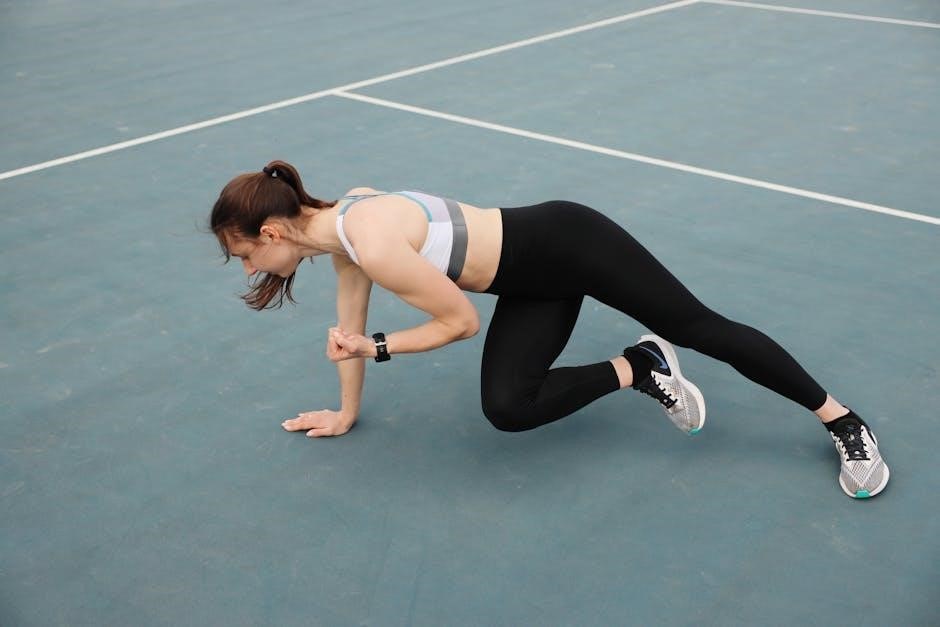
Golfers Elbow Exercises
Golfer’s elbow exercises focus on stretching and strengthening the forearm muscles. Stretching exercises target the flexor muscles, while strengthening exercises improve forearm stability and grip strength. Eccentric exercises are particularly effective for tendon repair, promoting recovery and preventing recurrence. These exercises are essential for restoring function and reducing pain, helping individuals return to their normal activities and sports.
4.1 Stretching Exercises for Flexor Muscles
Stretching exercises for the flexor muscles are essential to relieve tension and improve flexibility. Focus on wrist flexor stretches, holding each stretch for 20-30 seconds. These exercises target the forearm muscles, reducing stiffness and pain. Regular stretching helps restore range of motion and prevents further strain. Incorporate stretches like palm-up and palm-down wrist extensions to address tightness. Consistent practice can significantly alleviate symptoms and support recovery from golfer’s elbow.
4.2 Strengthening Exercises for Forearm
Strengthening exercises for the forearm are crucial to address golfer’s elbow. Focus on wrist curls, extensions, and grip exercises using light weights or resistance bands. These exercises help rebuild tendon strength and improve muscle endurance. Start with low resistance and gradually increase intensity. Strengthening the forearm muscles can reduce strain on the elbow, enhancing overall stability. Consistent practice of these exercises promotes faster recovery and helps prevent recurrence of symptoms.
4.3 Wrist Flexor and Extensor Stretches
Wrist flexor and extensor stretches are essential for relieving tension and improving mobility in golfer’s elbow. Start with the wrist flexor stretch: extend your arm, palm up, and gently pull your fingers back with your other hand. Hold for 20-30 seconds and repeat 2-3 times. For the extensor stretch, extend your arm, palm down, and gently pull your fingers back. These stretches target the forearm muscles and tendons, reducing stiffness and promoting healing. Regular practice helps prevent strain during golf or daily activities.
4.4 Eccentric Exercises for Tendon Repair
Eccentric exercises focus on the elongation phase of muscle contractions, crucial for tendon repair in golfer’s elbow. These slow, controlled movements target the forearm flexors. Start with a light weight or resistance band, lowering your wrist slowly over 3-5 seconds. Perform 3 sets of 10-15 repetitions daily. Eccentric exercises strengthen damaged tendons, improving resilience and reducing pain. They are often combined with stretching to restore flexibility and function, making them a cornerstone of rehabilitation programs for medial epicondylitis.
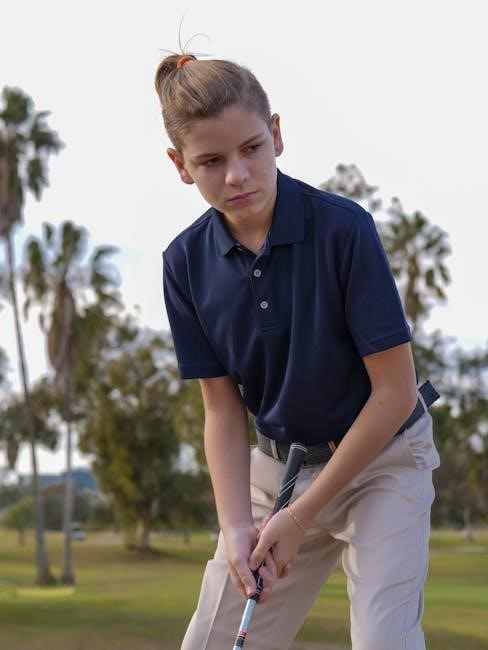
Preventing Golfers Elbow
Preventing golfer’s elbow involves proper warm-ups, avoiding repetitive strain, and using ergonomic adjustments. Strengthening forearm muscles and maintaining flexibility can reduce the risk of injury and recurrence.
5.1 Proper Warm-Up and Cool-Down
A proper warm-up and cool-down are essential for preventing golfer’s elbow. Start with light cardio to increase blood flow, then stretch the forearm flexors and extensors. Dynamic stretches, such as wrist circles and arm swings, prepare the muscles for activity. After exercise or play, gently stretch the same areas to reduce muscle tension and promote recovery. Consistent warm-up routines help maintain flexibility and strength, lowering the risk of injury.
5.2 Ergonomic Adjustments in Sports
Ergonomic adjustments in sports equipment and techniques can significantly reduce the risk of golfer’s elbow. Using properly fitted golf clubs and adjusting grip size can minimize strain on the forearm and elbow. Ensuring correct swing mechanics and avoiding over-gripping are also crucial. For other activities, like tennis, using rackets with appropriate string tension and grip size can help. These adjustments reduce repetitive stress on the tendons, lowering the likelihood of injury and enhancing overall performance.
5.3 Avoiding Repetitive Strain
Avoiding repetitive strain is essential for preventing golfer’s elbow. Limiting repetitive gripping, twisting, or flexing motions can reduce tendon stress. Taking regular breaks during activities and reducing the frequency or intensity of repetitive tasks helps prevent overuse. Incorporating rest periods and balancing activity with recovery time are key strategies. This approach minimizes the risk of tendon overload and supports long-term elbow health, especially for individuals engaged in sports or jobs requiring repetitive forearm movements.
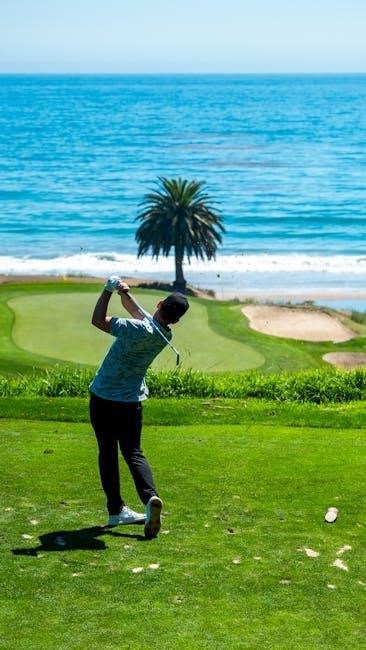
Treatment Options
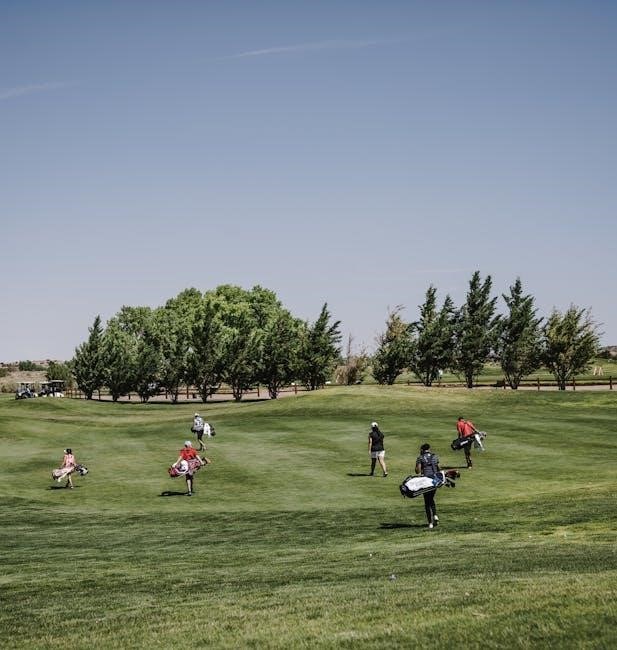
Treatment for golfer’s elbow often includes rest, ice therapy, and anti-inflammatory medications. Braces or splints may be used to support the elbow, while physical therapy and exercises can help restore strength and flexibility. In severe cases, corticosteroid injections or surgery may be necessary. Early intervention and a structured rehabilitation plan are key to effective recovery and preventing further injury.
6.1 Rest and Ice Therapy
Rest and ice therapy are fundamental in treating golfer’s elbow. Avoiding activities that strain the elbow allows the tendons to heal. Applying ice packs reduces inflammation and eases pain. Typically, ice should be applied for 15-20 minutes several times daily. Compression and elevation can further aid recovery. This initial treatment phase helps prevent further injury and prepares the elbow for subsequent rehabilitation exercises, ensuring a stronger and more stable recovery process over time.
6.2 Use of Braces and Supportive Devices
Braces and supportive devices are often recommended to alleviate golfer’s elbow symptoms. These devices, such as neoprene wraps or forearm straps, provide stability and reduce strain on the elbow joint. By compressing the affected area, they help minimize pain and inflammation. Braces can also be worn during activities to prevent further injury. While they offer relief, they are most effective when combined with rest, ice therapy, and a structured exercise program for comprehensive management of the condition.
6.3 Physical Therapy and Rehabilitation
Physical therapy is a cornerstone of golfer’s elbow rehabilitation, focusing on restoring strength, flexibility, and function. A licensed therapist can design a personalized program, incorporating stretching, strengthening, and eccentric exercises to target the affected tendons. Techniques like massage, ultrasound, or heat therapy may also be used to enhance healing. Regular sessions help improve joint mobility and reduce pain, ensuring a gradual return to normal activities. Consistency in therapy is key to achieving long-term recovery and preventing future flare-ups effectively.
6.4 Surgical Interventions (When Necessary)
Surgical intervention for golfer’s elbow is typically considered a last resort when conservative treatments fail to alleviate symptoms. Procedures may include arthroscopic or open surgery to remove damaged tendon tissue, repair tendon attachments, or release tight fascia. The goal is to relieve pain, restore mobility, and prevent further degeneration. Surgery is usually recommended after prolonged discomfort and limited response to physical therapy or rest. Recovery involves post-operative rehabilitation to ensure proper healing and regain elbow function effectively.
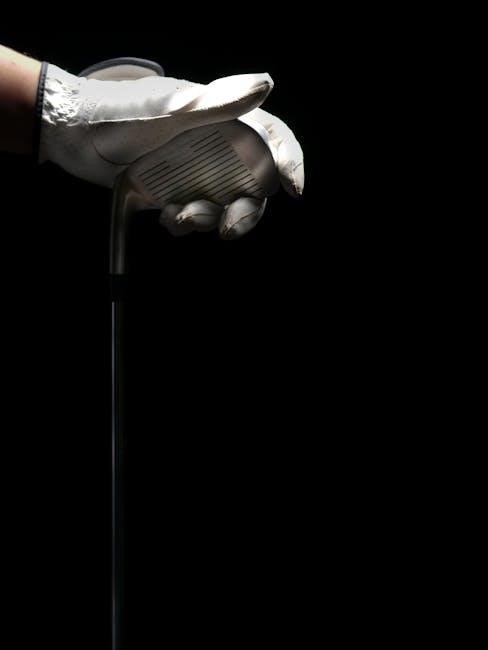
Exercises for Rehabilitation
Rehabilitation exercises focus on restoring strength, flexibility, and mobility in the elbow and forearm. They include isometric holds, gentle stretches, and progressive resistance to promote healing and prevent reinjury.
7.1 Isometric Exercises for Stability
Isometric exercises are essential for improving stability and strength without joint movement, reducing strain on the elbow. These exercises involve holding positions, such as wrist holds or palm squeezes, for extended periods. They help strengthen the forearm muscles and improve grip strength, which is crucial for golfers. Isometric exercises are often recommended in the early stages of rehabilitation to minimize pain while building muscle endurance. Regular practice can enhance joint stability and reduce the risk of reinjury, making them a cornerstone of Golfers Elbow recovery and prevention programs.
7.2 Progressive Resistance Training
Progressive Resistance Training (PRT) involves gradually increasing the intensity of exercises to build strength and endurance. For Golfers Elbow, this may include using light weights, resistance bands, or grip strengtheners. Over time, the resistance is increased to challenge the muscles further, promoting tendon repair and strength. PRT helps improve forearm and wrist strength, reducing the risk of reinjury and enhancing overall function. It is a key component of rehabilitation, allowing individuals to return to their activities with improved resilience and performance.
7.3 Flexibility and Mobility Drills
Flexibility and mobility drills are essential for improving range of motion and reducing stiffness in the elbow and forearm. These exercises focus on stretching the wrist flexors, forearm muscles, and tendons. Techniques include wrist flexor stretches, forearm stretches, and gentle rotational movements of the elbow. Regular mobility drills enhance blood flow, promoting tendon repair and reducing pain. Consistency is key to restoring flexibility and preventing future injuries, ensuring the elbow and forearm remain supple and functional during daily activities and sports. Proper technique is crucial to avoid aggravating the condition.
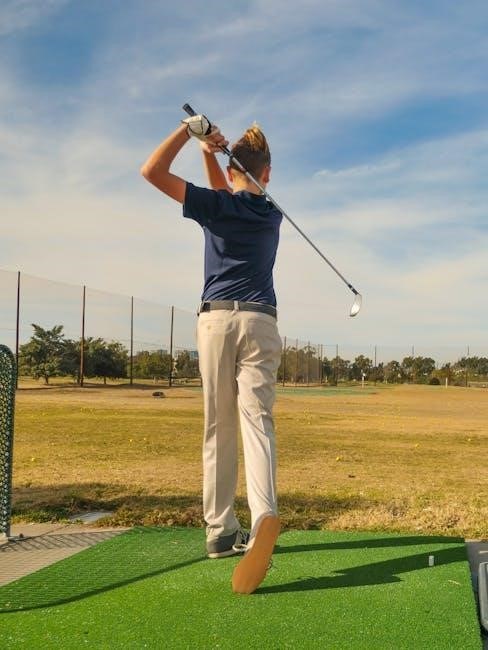
Alternative Therapies
Alternative therapies like massage, PRP injections, and ultrasound therapy can complement exercises, promoting tendon healing and reducing inflammation for golfers elbow relief.
8.1 Massage Therapy for Muscle Relaxation
Massage therapy is a beneficial alternative treatment for golfers elbow, focusing on relaxing tense forearm muscles and improving circulation. Techniques like deep tissue or Swedish massage can reduce pain and stiffness. Regular sessions help alleviate muscle spasms and promote healing. Massage also breaks down scar tissue, enhancing tendon repair and flexibility. It complements exercises by preparing muscles for stretching and strengthening, making it an effective addition to a comprehensive recovery plan for medial epicondylitis.
8.2 Platelet-Rich Plasma (PRP) Injections
Platelet-rich plasma (PRP) injections are an innovative treatment for golfers elbow, utilizing the body’s own healing properties. PRP, derived from the patient’s blood, is rich in growth factors that stimulate tendon repair. Injected into the affected area, it promotes collagen synthesis and tissue regeneration. This minimally invasive therapy is effective for chronic cases, reducing pain and inflammation while enhancing recovery. PRP injections are often combined with physical therapy and exercises to restore elbow function and prevent future injuries.
8.3 Ultrasound and Heat Therapy
Ultrasound and heat therapy are common alternatives for treating golfers elbow, enhancing recovery by reducing pain and inflammation. Ultrasound uses high-frequency sound waves to stimulate blood flow and promote tendon healing. Heat therapy, such as warm compresses or thermal wraps, relaxes muscles and improves flexibility. These methods are often combined with exercises to enhance their effectiveness. They provide non-invasive relief, making them suitable for patients seeking to avoid more invasive treatments like injections or surgery.
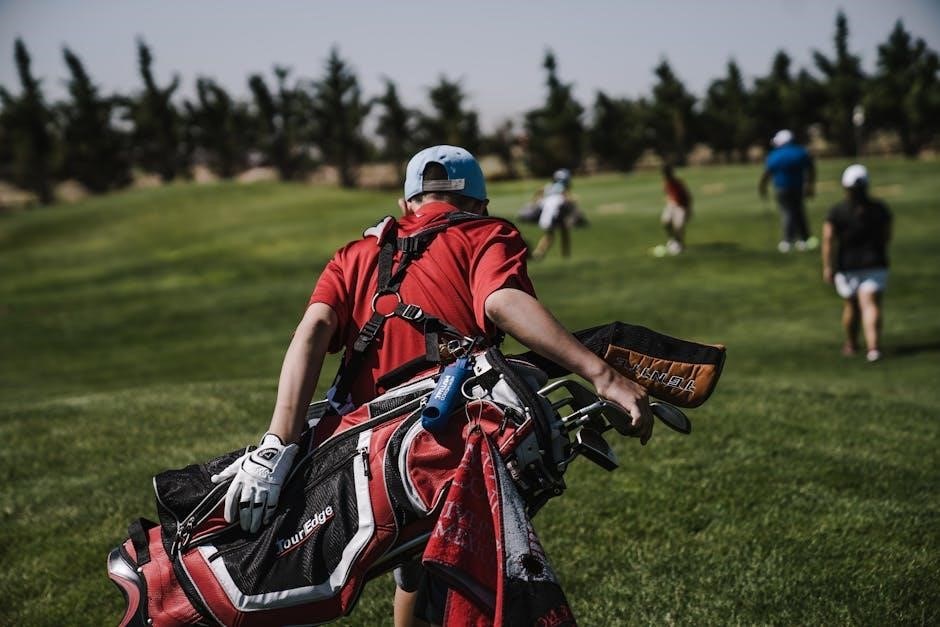
Golf Swing Adjustments
Proper golf swing mechanics are vital to prevent golfer’s elbow. Adjusting grip, stance, and follow-through can reduce strain on the elbow, minimizing injury risks and enhancing performance.
9.1 Correct Grip and Stance
A proper grip and stance are essential to avoid golfer’s elbow. A neutral grip avoids excessive wrist rotation, reducing strain on the forearm muscles. Standing with feet shoulder-width apart promotes balance, allowing smoother weight transfer during the swing. Ensuring the elbows are slightly bent and relaxed helps distribute force evenly, minimizing the risk of overuse injuries. These adjustments not only prevent discomfort but also improve overall swing efficiency and accuracy.
9.2 Follow-Through Techniques
Proper follow-through in golf is crucial for reducing elbow strain. A smooth, controlled motion after impact helps distribute force evenly, minimizing stress on the forearm and elbow. Avoiding sudden wrist snaps or twists during the follow-through can prevent overuse injuries. Maintaining a balanced finish reduces the risk of inflammation and tendon strain, promoting long-term elbow health. Practicing slow, deliberate swings can help master these techniques, ensuring a safer and more effective golfing experience.
9.3 Reducing Strain on the Elbow
Reducing strain on the elbow involves modifying swing mechanics to minimize repetitive stress. Using a neutral grip and avoiding over-swinging can alleviate pressure on the medial tendons. Strengthening core muscles improves stability, while flexible shaft clubs reduce vibration impact. Proper warm-up routines and avoiding over-practice are key. Incorporating exercises that focus on forearm flexibility and tendon strength, as outlined in golfer’s elbow exercise PDFs, helps prevent recurrence and enhances overall elbow resilience during gameplay.
Golfer’s elbow is manageable with proper exercises, rest, and technique adjustments. Consistency in treatment and awareness of preventive measures are key to long-term recovery and elbow health.
10.1 Summary of Key Points
Golfer’s elbow, or medial epicondylitis, is a condition causing pain on the inner elbow and forearm due to overuse or repetitive strain. It often affects golfers, tennis players, and individuals with repetitive gripping activities. Symptoms include tenderness near the elbow, pain during wrist flexion, and discomfort when performing daily tasks. While it can interfere with sports and daily life, targeted exercises play a crucial role in recovery and prevention. Proper rest, stretching, and strengthening exercises are essential for managing symptoms and restoring elbow function. Early intervention and lifestyle adjustments can prevent long-term issues and improve overall elbow health.
10.2 Long-Term Management and Recovery
Long-term management of golfer’s elbow involves maintaining a consistent exercise routine, focusing on stretching and strengthening the forearm muscles. Ergonomic adjustments to sports equipment and work tools can reduce strain; Gradual return to activities, avoiding repetitive stress, is crucial. Regular physical therapy check-ups and incorporating alternative therapies like massage or ultrasound can aid recovery. Proper warm-up and cool-down routines should become a permanent part of one’s regimen to prevent relapse and ensure lasting elbow health.
